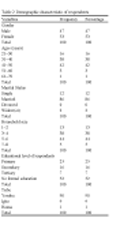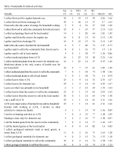Multiple Land Use Benefits of Peri-urban Forest (Arakanga Forest Reserve, Ogun State, Nigeria): Perception of Resource Users and its Implication 
Federal University of Agriculture, Abeokuta
Federal University of Agriculture, Abeokuta
 Author
Author  Correspondence author
Correspondence author
International Journal of Molecular Ecology and Conservation, 2012, Vol. 2, No. 5 doi: 10.5376/ijmec.2012.02.0005
Received: 26 Oct., 2012 Accepted: 31 Oct., 2012 Published: 30 Nov., 2012
Soaga et al., 2012, Multiple Land Use Benefits of Peri-urban Forest (Arakanga Forest Reserve, Ogun State, Nigeria): Perception of Resource Users and its Implication, International Journal of Molecular Ecology and Conservation, Vol.2, No.5, 26-31 (doi: 10.5376/ijmec.2012.02.0005)
The study examined multiple land use benefits in a peri-urban forest in Abeokuta, Ogun State, Nigeria and the perception of resource users on the significance of the benefits. Stratified Random Sampling technique was used for the study with 100 respondents selected. The settlement was divided into four strata based on existing pattern in the area. The four strata are Ajegule, Ibode Olude, Ilugun Titun and Mawuko. From each stratum, twenty five respondents were randomly selected with a total of 100 respondents from the study area. Questionnaire and interview were used as the instrument of data collection. The benefits derived from the reserve cut across all age groups, ethnic background, educational levels and marital status of respondents. The forest reserve provides multiple benefits in terms of goods and services and environmental protection. Mantel measurement for combined benefits showed firewood as the most dominant with indispensible value of 34 followed by Teak leaves collection 24 and 16 for geological material extraction. The major objective of the reserve is timber and poles production but simultaneously other multiple benefits such as firewood, snails, teak leaves, medicinal plants, bushmeat and geological materials were derived from the reserve. Consequently, the forest reserve contributes to livelihoods of the surrounding communities. This was measured through perception of the respondents with positive mean values and standard deviation of Likert rating. It is therefore recommended that increased conservation effort must be ensured through appropriate forest policy formulation along with the introduction of alternative domestic energy source to firewood to enable the forest contribute more to the welfare of surrounding communities.
Tropical countries in Africa, especially Nigeria, lay emphasis on management and protection of forest through forest reservation. This process of reservation has significant social, economic and environmental impacts. Reservation of forests, especially urban and peri-urban forests, gives rise to benefits in terms of conservation of biodiversity. The bio-diversity of plants and animals provides goods and services. The myriad of goods and services provided by urban and peri-urban forest have been widely reported (Osemeobo et al., 1986; Adekunle, 1998; FAO, 2001, ftp://ftp.fao.org/docrep/fao/009/y0353e/y0353e00.pdf), they are timber and non-timber based: examples include sawn wood, fuel wood, medicines, leaves, roots, bark, mushroom, wild animals and geological materials such as sand, gravels, stones and soils. However, the forests were hitherto valued as land banks rather than a valuable resource of its own right providing essential goods and services for livelihood generation. Consequently, the forest is a key com- ponent is a natural resource base of any community or country especially in developing countries. This is particularly so in third world countries located within tropical forest formation including Nigeria where most of the countries have large rural populations depending on natural resource exploitation for their livelihood. According to CIFOR (2005), apart from the forest meeting the economic needs of the rural people for food and shelter, tropical forests are also a major source of both industrial wood products and fuelwood. WCMC (2000) reported that in Nigeria, rainforest is home to over 1 417 known species in fauna and at least 4 715 species of vascular plants. Therefore, forests have the highest species diversity of any terrestrial ecosystem in the world. Forests therefore provide employment for people and contribute to the GDP of the nation. Forest resources in Nigeria are distributed on state basis with eight major forest types (Beak Consultant, 1998). As one of the states with forest resources, Ogun State has forest reserve that falls under the purview of a peri-urban forest. According to Wiggins and Holt (2000), peri-urban was described as areas beyond the closed settled limits of any urban area but are sufficiently close enough to the urban area to have frequent and substantial interactions with the urban economy. Close enough was taken to mean within 30 minutes of journey of the city by public transport. This expression describes Arakanga forest reserve in Abeokuta, Ogun State, Nigeria. As a peri-urban forest there are growing settlements developing close to the forest in view of the benefits derivable from the forest. This is in addition to the interaction with the urban economy. The values of a peri-urban Forest transcend the valuation of forests as land banks as hitherto was the perception of early settlers. The list of goods and services that urban forestry and peri-urban forestry can provide is impressive. Trees and green spaces help keep cities cool, act as natural filters and noise absorbers; improve microclimates and protect and improve the quality of natural resources, including soil, water, vegetation and wildlife. Trees contribute significantly to the aesthetic appeal of cities, thereby helping to maintain the psychological health of their inhabitants. Beyond ecological and aesthetic benefits, urban forestry has a role in helping resource – poor populations meet basic needs. This therefore underscores the importance of this study with the following objectives:
1 The study area
The major occupation of the people in the study area is farming with agricultural crops such as cassava, maize, cocoyam, plantain, palm produce and vegetables. The area is also rich in fauna resources such as fish of various species, grasscutter, giant rat, grey rat, monitor lizard, weaver birds and others. Stone quarrying is also well developed. Major non-farm employments are provided by transportation and forestry activities such as timber exploitation, firewood, leaves collection and charcoal production.
2 Data collection
3 Data analysis
3.1 Multiple benefits
|
Table 1 Multiple benefits (Mantel, 1965)
|
4 Results and Discussion
|
Table 2 Demographic characteristic of respondents
|
The table shows that the respondents were mostly females with 53% and 47% for males. On age distribution, 42% of the respondents were between the ages of 41 to 50 years of age, followed by 38% who falls between the range of 31 to 40 years of age, then 16% of the respondents were between ages 21 to 30 years, while 3% of the respondents were between ages 51 to 60 and 1% were between 61 to 70%.
The table also shows that majority of the respondents were married with 86%, while 12% were single and 2% widower.
The household size of the respondents ranged from 1 to 8. The respondents that constitute the majority was household size of 5 to 6 with 44%, followed by those with 3 to 4 having 38%. Also, 13% have household size of 1 to 2 and 5% have household size of 7 to 8.
Furthermore on education, majority 52% of the respondents had no formal education, 25% had Primary education, while 16% had Secondary education and only 7% of the respondents had Tertiary education.
Furthermore on education, majority 52% of the respondents had no formal education, 25% had Primary education, while 16% had Secondary education and only 7% of the respondents had Tertiary education.
4.1 Multiple benefits derived from the reserve
|
Table 3 Evaluation of combined benefits derived from the reserve
|
4.2 Perception and implication
|
Table 4 Sustainable livelihood activities
|
Conclusion
Conservation efforts should be based on integrated managements that help to maintain the environment, offer better socio-economic options that would lead to an adequate and acceptable quality of life for the teaming rural and urban poor who depended on forest and forest products, and at the same time, maintain biological diversity. An alternative source of energy should also be made available to the teaming population who depended on the forest reserve for firewood collection as source of domestic energy.
Oseomobo G.J., Omoluabi A.C., Okonofua S.A., and Offokansi L.I., 1986, Pre-feasibility study on urban forestry development in Nigeria, Prepared by Consultancy Unit, Federal Dept. of Forestry, Lagos, Nigeria, pp.101
. PDF(500KB)
. FPDF
. HTML
. Online fPDF
Associated material
. Readers' comments
Other articles by authors
. Jubril Soaga
. Oladapo Oduntan
. Abdul Lateef Shotuyo
Related articles
. Dominant use
. Combined benefits
. Human dimension
. Natural resource
Tools
. Email to a friend
. Post a comment




